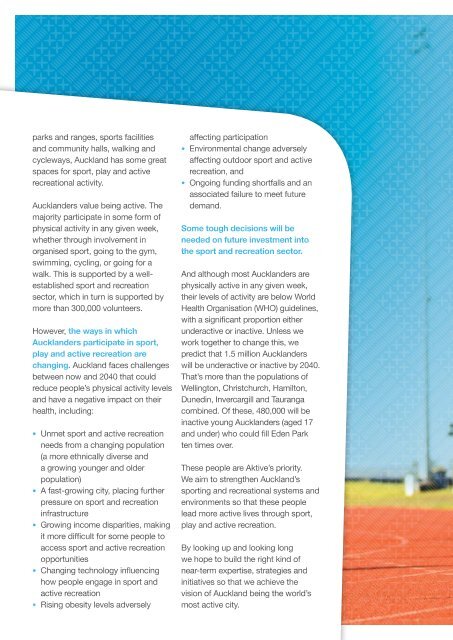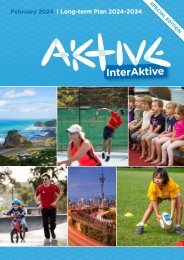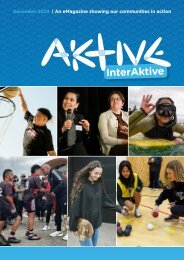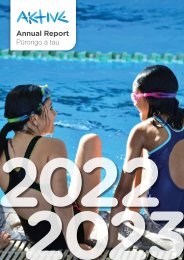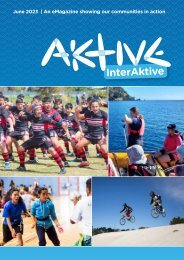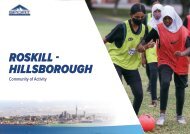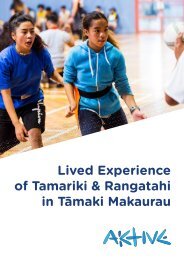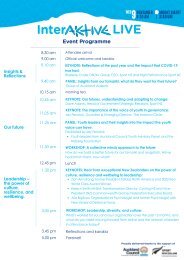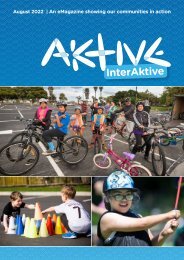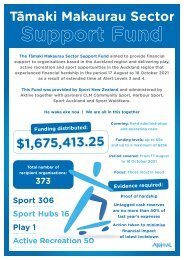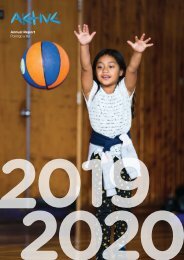Aktive's Strategic Framework 2020-2040
You also want an ePaper? Increase the reach of your titles
YUMPU automatically turns print PDFs into web optimized ePapers that Google loves.
parks and ranges, sports facilities<br />
and community halls, walking and<br />
cycleways, Auckland has some great<br />
spaces for sport, play and active<br />
recreational activity.<br />
Aucklanders value being active. The<br />
majority participate in some form of<br />
physical activity in any given week,<br />
whether through involvement in<br />
organised sport, going to the gym,<br />
swimming, cycling, or going for a<br />
walk. This is supported by a wellestablished<br />
sport and recreation<br />
sector, which in turn is supported by<br />
more than 300,000 volunteers.<br />
However, the ways in which<br />
Aucklanders participate in sport,<br />
play and active recreation are<br />
changing. Auckland faces challenges<br />
between now and <strong>2040</strong> that could<br />
reduce people’s physical activity levels<br />
and have a negative impact on their<br />
health, including:<br />
• Unmet sport and active recreation<br />
needs from a changing population<br />
(a more ethnically diverse and<br />
a growing younger and older<br />
population)<br />
• A fast-growing city, placing further<br />
pressure on sport and recreation<br />
infrastructure<br />
• Growing income disparities, making<br />
it more difficult for some people to<br />
access sport and active recreation<br />
opportunities<br />
• Changing technology influencing<br />
how people engage in sport and<br />
active recreation<br />
• Rising obesity levels adversely<br />
affecting participation<br />
• Environmental change adversely<br />
affecting outdoor sport and active<br />
recreation, and<br />
• Ongoing funding shortfalls and an<br />
associated failure to meet future<br />
demand.<br />
Some tough decisions will be<br />
needed on future investment into<br />
the sport and recreation sector.<br />
And although most Aucklanders are<br />
physically active in any given week,<br />
their levels of activity are below World<br />
Health Organisation (WHO) guidelines,<br />
with a significant proportion either<br />
underactive or inactive. Unless we<br />
work together to change this, we<br />
predict that 1.5 million Aucklanders<br />
will be underactive or inactive by <strong>2040</strong>.<br />
That’s more than the populations of<br />
Wellington, Christchurch, Hamilton,<br />
Dunedin, Invercargill and Tauranga<br />
combined. Of these, 480,000 will be<br />
inactive young Aucklanders (aged 17<br />
and under) who could fill Eden Park<br />
ten times over.<br />
These people are Aktive’s priority.<br />
We aim to strengthen Auckland’s<br />
sporting and recreational systems and<br />
environments so that these people<br />
lead more active lives through sport,<br />
play and active recreation.<br />
By looking up and looking long<br />
we hope to build the right kind of<br />
near-term expertise, strategies and<br />
initiatives so that we achieve the<br />
vision of Auckland being the world’s<br />
most active city.<br />
Aktive’s goal is for<br />
1.5 million<br />
more Aucklanders to be<br />
active by <strong>2040</strong>


